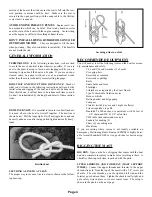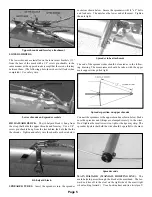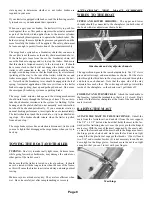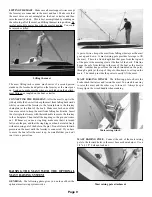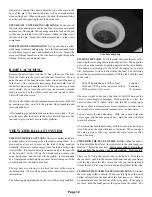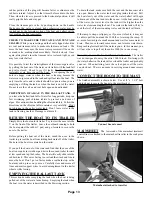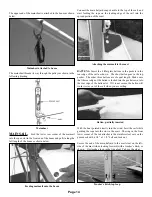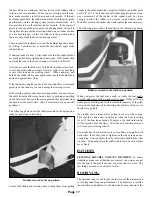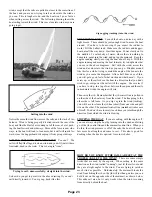
state agency to determine whether or not trailer brakes are
required in your area.
If your trailer is equipped with brakes, read the following careful-
ly to make sure you understand their operation.
When you apply your car brakes, the trailer will try to push for-
ward against the car. This push compresses the actuator mounted
as part of the hitch, which applies force to the master cylinder,
which creates hydraulic pressure to operate the trailer brakes. The
harder you stop, the more hydraulic pressure you generate, and the
more forcefully the brakes will be applied. The safety chain must
be loose enough to permit free motion of the actuator assembly.
The surge brake system has a breakaway chain that connects to
the car (this is not the same as the safety chain mentioned above).
If the trailer gets loose from the car, the breakaway chain will
cause the brakes to engage and try to stop the trailer. Make sure
that this chain is fastened securely to the tow vehicle. It should
have some slack so that it will not engage the brakes while the
trailer is still connected to the car. The chain should be loose
enough, even during turns, so that the breakaway lever is released
(pointing all the way to the rear of the trailer) while the car and
trailer are engaged. Check this each time before you use the trail-
er. No teeth on the breakaway lever should be engaged in the leaf
spring. Accidental application of the lever will cause the trailer
brakes to engage, drag, heat up and perhaps burn out. Do not use
the emergency breakaway system as a parking brake.
The surge brake actuator linkage and the sliding mechanisms
should work freely through the full range of travel. Do not mis-
take shock absorber resistance in the system for binding. Nylon
bearings and the plated shafts do not normally need lubrication,
but should be checked periodically. If you encounter erratic or
unusual braking performance, investigate the cause immediately.
The trailer should not push the tow vehicle, or try to jackknife dur-
ing stops. The brakes should release when the trailer is pulled
from a dead stop.
The surge brake system has an electronic disconnect, tied in with
your car’s lights, that disengages the surge brakes when you try to
back up.
TOWING THE BOAT AND TRAILER
TURNING.
Don’t try to make really tight turns. Extreme turns,
while going forward or backwards, may damage the actuator or
other parts of the trailer or car.
Make sure that the trailer is towed in a level position. It should
never be towed with the tongue lower than the rear of the frame,
as this will cause the brakes to activate and stay on during normal
towing.
Make sure your car brakes stay dry. They are less efficient when
wet. Be extra careful just after ramp launching or recovery.
ATTACHING THE MAST
SUPPORT
WIRES TO THE BOAT
UPPER AND LOWER SHROUDS.
The upper and lower
shrouds should be connected to the chainplates (on both sides of
the boat) with stay adjusters as shown below.
Side shrouds and stay adjuster channels
The upper shroud goes in the rear chainplate hole. Use 1/4” clevis
pins and cotter rings, and mount them as shown. Put the clevis
pins through the third hole in the strap as shown, and through the
end hole in each channel. Note that the open side of the stay
adjusters face each other. The cotter rings should go toward the
inside of the chainplate, so the sheets won’t pull them off.
FORESTAY AND TURNBUCKLE.
Attach the turnbuckle to
the forestay. Adjust the turnbuckle so that it is 1/3 closed. Don’t
attach it to the forestay chainplate at the front of the boat until the
mast is raised.
RAISING THE MAST
ATTACH THE MAST TO THE MAST HINGE.
Unbolt the
mast from the forward rail, and unbolt it from the rear support.
The 3/8” x 4 1/2” bolt and lock nut that holds the mast to the for-
ward rail for trailering also serves as the pivot pin for the hinged
mast step. With the rear of the mast supported by the mast carri-
er, move the forward end of the mast back to the hinge area. Insert
the hinge pin (see below) and make sure the lock nut is on tight
enough that the plastic seal engages the threads. (You will need
two 9/16” end wrenches for this.) It is not necessary to run the nut
down tight on the hinge plates. Just make sure the nut is on tight
enough so that you can’t turn it with your fingers.
Mast hinge
Page 8
Содержание 26 M
Страница 28: ...Page 28...




